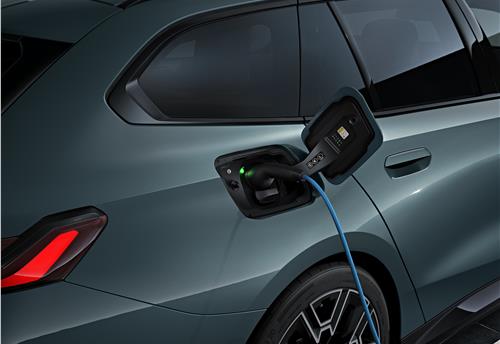Lanxess, Boge Elastmetall develop world’s first all-plastic brake pedal for electric sports car
The all-plastic brake pedal is around 50 percent lighter than a comparable steel design, and the manufacturing process is suitable for large-scale production using hybrid moulding.
German specialty chemicals company Lanxess’ High Performance Materials (HPM) business unit and Boge Elastmetall, a global provider of vibration technology and plastics applications for the automotive industry have developed the world’s first all-plastic brake pedal for an electric sports car, where EV every gram of weight counts.
The plastic brake pedal has high mechanical strength and very low weight to a thermoplastic composite design. Its structure comprises an insert made from Tepex dynalite, a continuous-fibre-reinforced thermoplastic composite from Lanxess, and several tapes.
Dr. Klaus Vonberg, an expert in lightweight design at HPM’s Tepex Automotive Group said: “The composite structure makes the brake pedal 50 percent lighter than a comparable steel design. The structural component meets the demanding load requirements thanks to the tailor-made fibre-layer construction of the Tepex insert and additional local tape reinforcement. Extensive automation allows the geometrically complex safety-critical component to be manufactured efficiently and in a way that is suitable for large-scale production.”
The fully consolidated semi-finished products Tepex dynalite have a thermoplastic matrix that is typically reinforced with layers of continuous glass-fibre fabric. The brake pedal for the battery-electric sports car uses a composite structure with a polyamide 6 matrix, which contains unidirectional fibre layers inside and fabric layers with fibres arranged at 45deg angles on the two covering layers. The inner layers are what give the component its excellent tensile and bending strength.
Tapes are thin plastic strips with unidirectionally oriented, high-strength continuous fibre systems embedded in the thermoplastic matrix. Multiple tapes with glass-fibre rovings are used in the brake pedal to reinforce the bottomside of the component. Since the tapes and the Tepex insert consist of mutually compatible plastic matrices, the tapes can simply be welded onto the Tepex insert using a laser. This results in tailor-made laminates with fibre layers that follow the load paths precisely and are adapted to the exact load-specific component requirements. The covering layers of the insert with their 45deg fibre layers, combined with the tapes on top, thereby ensure the high torsional strength of the pedal.
Four brake pedal versions in series production
Dr. Daniel Haffelin, from the Innovation Center at Boge Elastmetall said: “This tailor-made fibre-layer structure and the combination of organic sheets and tapes have made it possible to reduce brake pedal weight even further while simultaneously achieving the exceptionally high level of mechanical characteristics that such a safety-critical component needs to provide.”
There are currently four different brake pedal designs in mass production based on an all-plastic version. For all component versions, the load paths are also optimised to suit the various torsion directions.
The brake pedals are manufactured in an automated process using hybrid moulding in short cycle times suitable for large-scale production. The method integrates draping of the Tepex insert and the tapes in the subsequent injection moulding process. The first stage of production involves aligning the tapes precisely using optical measuring systems and then positioning them on the Tepex insert so that they can be welded to it. This assembly is thermoformed and then back-moulded with polyamide 66 by an injection moulding process.
High-strength structural components for EVs
The partners say new opportunities are opening up in the field of electric vehicles for thermoplastic composite structures with tailored fibre orientation. According to Vonberg, “Examples of applications for Tepex inserts include front-end systems and bumper beams, brackets for electrical and electronic modules, trunks and spare wheel wells, battery housings and covers, structural components in the vehicle's 'greenhouse' section and structural trims in the underbody area to protect the battery.”
The low carbon footprint relative to metal-based structures is another point in favour of the composite design with Tepex and tapes. Thermoplastic composites are not only much lighter than such alternatives, but the hybrid moulding method used means that they also enable functions such as guides, holders and fasteners to be integrated in a way that saves weight, energy and costs. With components of this type, there is no need for time-consuming further processing such as deburring or post-process tapping, as this is typical for metal parts.
RELATED ARTICLES
Nissan shows in-construction all-solid-state battery pilot line in Japan
Under the Nissan Ambition 2030 long-term vision, Nissan aims to launch EVs equipped with the batteries by fiscal year 20...
BMW Group sells 82,700 BEVs in Q1 2024, sees growth across all key markets
The company has delivered a total of 82,700 fully-electric BMW, Mini and Rolls-Royce vehicles to customers worldwide, up...
Lanxess and IBU-tec to develop iron oxides for LFP EV batteries
Collaboration aims to improve performance of LFP cathode material; reduced carbon footprint of batteries through use of ...





 By Autocar Pro News Desk
By Autocar Pro News Desk
 05 May 2020
05 May 2020
 8343 Views
8343 Views









